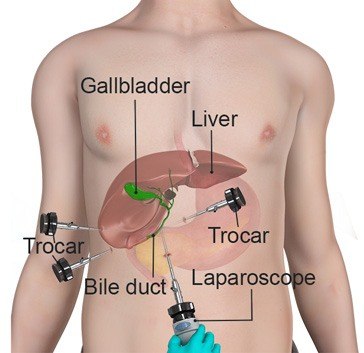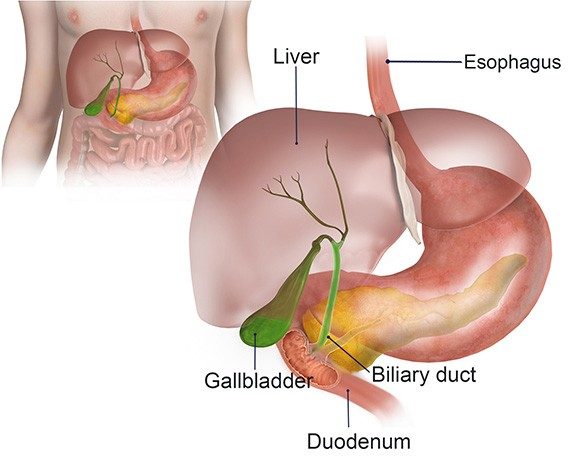Bile Duct Surgery

What is laparoscopic bile duct surgery?
Laparoscopic bile duct surgery is a minimally invasive procedure performed to diagnose and treat various conditions of the bile ducts caused by its blockage.
Crystallised stones formed in the gallbladder due to an imbalance in the contents of bile can pass into the bile duct and cause an obstruction. Laparoscopic bile duct surgery is usually performed when stones are detected in the bile duct at the time of the gallbladder surgery.
What are bile ducts? How do they get obstructed?
Bile ducts are narrow tubes that transport bile, a fat digesting fluid, released by the liver into the small intestine. Bile is temporarily stored in a pear-shaped organ called the gallbladder. The bile ducts can get obstructed partially or completely by gallbladder stones, cysts or tumours, abnormal narrowing of the duct, trauma, infection, inflammation of the ducts, inflammation of the pancreas (pancreatitis) and liver diseases, disrupting the normal flow of bile and leading to jaundice.

What causes the formation of gallstones?
The risks of developing gallstones may include:
- Being female
- Being obese
- Suffering from pancreatitis
- Having lost weight rapidly
What are the symptoms of gallstones?
The obstruction of the biliary tract can lead to light coloured stools, dark urine, jaundice, abdominal pain, nausea/vomiting, weight loss and fever.
How is a biliary obstruction diagnosed?
A biliary obstruction can be diagnosed through blood tests, and various imaging studies such as ultrasound, biliary radionuclide scan (HIDA scan), MRI scan, magnetic resonance cholangiopancreatography (MRCP) and endoscopic retrograde cholangiopancreatography (ERCP).
What are the consequences of not treating a biliary obstruction?
Left untreated, a biliary obstruction can lead to the build-up of bilirubin, chronic liver disease, sepsis and a life-threatening infection.
What are the indications of the different laparoscopic bile duct surgeries?
Ideally bile duct stones can be removed by the endoscopic procedue ERCP. For stones that cannot be removed endoscopically a laparoscopic or open bile duct surgery is required.
The following are the indications for the different laparoscopic bile duct surgeries:
- Laparoscopic common bile duct exploration: To remove stones that travel from the gallbladder and obstruct the bile duct.
- Laparoscopic bile duct bypass: To provide a bypass for bile duct strictures (narrowing of the bile duct)
- Laparoscopic choledochal cyst removal: To remove cysts from the bile duct
Laparoscopic bile duct surgery is indicated to treat most bile duct obstructions, but may be contraindicated in the following cases:
- Severe inflammation of the pancreas and advanced liver disease
- Previous upper abdominal surgery
- Gallbladder cancer
In these cases, an open approach is chosen.
How do I prepare for laparoscopic bile duct surgery?
Before laparoscopic bile duct surgery, your surgeon will order certain tests to evaluate your condition. You will be instructed to stop smoking, and fast for at least 6 hours pre operatively. Discuss with your surgeon about the medications that you take on a regular basis. You will be advised on those that you can continue and those you need to stop taking. You will be briefed on the procedure and what you should expect from the surgery.
What treatment choices are available for biliary obstruction?
Some of the laparoscopic bile duct procedures include:
- Laparoscopic cholecystectomy: a procedure to remove the entire gallbladder
- Laparoscopic common bile duct exploration: a procedure to extract stones from the bile duct
- Laparoscopic bile duct bypass: a procedure to bypass blocked or narrowed bile ducts
- Laparoscopic choledochal cyst removal: a procedure to remove cysts in the bile duct
How is laparoscopic bile duct surgery performed?
Laparoscopic bile duct surgery is performed using a laparoscope, which is a thin long tube with a camera attached. Your surgeon makes 4 small incisions (less than 2 cm) around the belly button. The laparoscope is inserted through one of them. This provides a clear magnified view of the surgical region on a large monitor. Surgical instruments are inserted through the other incisions. The individual procedures are described below.
Laparoscopic cholecystectomy
Laparoscopic cholecystectomy is performed to remove the gallbladder along with a gallbladder stone(s). It is usually performed under general anaesthesia. Once the gallbladder is located, your surgeon carefully releases it from its attachments and removes it through one of the incisions. The incisions are then closed. The operation usually takes less than an hour.
Laparoscopic common bile duct exploration
Laparoscopic common bile duct exploration is performed under general anaesthesia with you lying on your back. Laparoscopic common bile duct exploration can be performed through two approaches:
- Transcystic approach: The cystic duct (opening out from the gallbladder) is exposed and an incision is made.
- Choledochotomy: The common bile duct (common duct that receives fluids from the gallbladder and liver) is exposed and an incision is made.
A cholangiogram catheter, a thin long tube with a balloon tip is introduced. The balloon is inflated and a dye is injected, which helps detect the exact position and structure of the gallstone under X-ray imaging. Your surgeon may then remove the stones by:
- Flushing them with saline
- Retrieving them using a basket
- Retrieving them using a choledochoscope (long lighted tube)
- Using laser to ablate the stones
Laparoscopic bile duct bypass
Laparoscopic bile duct bypass is performed under general anaesthesia. The blockage is identified and the region before the block is connected to the region after the block to form a bypass around the constriction. Following this, the incisions are closed with sutures.
Laparoscopic choledochal cyst removal
Laparoscopic choledochal cyst removal is a minimally invasive surgery where the choledochal cyst obstructing the flow of bile is completely removed along with the abnormal segment of the bile duct. The normal section of the bile duct is then sutured to the small intestine, routing the bile secretions into the intestine.
What can I expect after laparoscopic bile duct surgery?
Following laparoscopic bile duct surgery, you may experience pain and discomfort. Your surgeon will prescribe medication to keep you comfortable.
You are encouraged to walk as soon as you comfortable after the procedure. Your wounds will be covered with waterproof dressings allowing you to shower normally. They are usually left in place until your post operative review appointment.
Describe the stages of recovery and care plan.
Following laparoscopic bile duct surgery, you will be required to stay in the hospital for 1-3 days. Return to work is generally 1-2 weeks. You will be able to continue with your normal diet.
Avoid excessive bending or twisting for 1-2 weeks, and lifting heavy objects for 2-4 weeks. Consult your surgeon on when you can start driving.
Consult your doctor immediately if you experience fever, redness or drainage from your incisions, develop yellow colouration in your skin or eyes, pain persists or worsens, shortness of breath or swelling in your legs.
What are the potential complications of laparoscopic bile duct surgery?
As with all surgical procedures, laparoscopic bile duct surgery may be associated with certain complications such as infection, jaundice, bile duct leaks and retained stones.
How long will I be off work?
You can resume work in 1 or 2 weeks after surgery.
What are the benefits of laparoscopic bile duct surgery?
The advantages of laparoscopic bile duct surgery over the open approach include:
- Smaller surgical incisions
- Less postoperative pain
- Less scarring
- Quicker recovery
- Shorter hospital stay
What is the cost of the procedure?
We will provide you with a full explanation of the costs of the operation to assist you in your decision to proceed. The costs will vary depending on your level of private health insurance.
What are the current research regarding laparoscopic bile duct surgery?
Ongoing research on laparoscopic bile duct surgery include:
- Yu H, Wu S, Yu X, Han J, Yao D. Single-incision laparoscopic biliary bypass for malignant obstructive jaundice. J Gastrointest Surg. 2015 Jun;19(6):1132-8.
- Berti S, Ferrarese A, Feleppa C, et al. Laparoscopic perspectives for distal biliary obstruction. Int J Surg. 2015 Sep;21 Suppl 1:S64-7.






